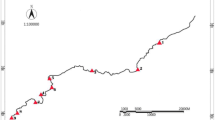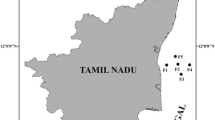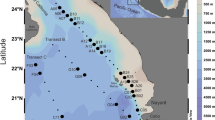Abstract
The spatial and temporal variability of the phytoplankton community structure in Daya Bay, South China Sea, were identified by using HPLC-CHEMTAX analytical techniques. The highest chlorophyll a (Chl a) concentrations were observed during summer (with an average value of 0.84 μg/L) and lowest ones during winter (with an average value of 0.33 μg/L). CHEMTAX processing revealed the seasonal succession of phytoplankton species in Daya Bay. During winter, diatoms were the dominant phytoplankton species and contributed 41.5% to total Chl a. Based on Chl a concentration, the average ratio of dinoflagellates to total phytoplankton biomass substantially increased with increasing temperature and nitrogen to phosphorus (N/P) ratio, reaching 52.2% in spring. Nutrient limitation shifted from phosphorus to nitrogen during summer. Moreover, this period was associated with the predominance of diatoms, which accounted for 71.1% of Chl a. Prasinophytes and cryptophytes were the other two dominant groups and particularly dominated during winter. Cyanobacteria became an important group during summer and autumn. Canonical correspondence analysis suggested that chrysophytes, dinoflagellates, and cryptophytes were strongly associated with high nitrate concentration, ammonium, dissolved inorganic nitrogen (DIN), and N/P ratio, and were negatively associated with temperature and phosphate. Diatoms and cyanobacteria were strongly associated with temperature, phosphate, and salinity, and are negatively influenced by nitrate, ammonium, DIN, and N/P ratio. Microscopic observations and pigment HPLC information were in good agreement for diatoms and dinoflagellates in the bay. This study demonstrated the usefulness of pigment analysis in investigating the distribution of phytoplankton groups in a complex physical environment, such as Daya Bay.
Similar content being viewed by others
References
Aiken J, Pradhan Y, Barlow R, Lavender S, Poulton A, Holligan P, Hardman-Mountford N. 2009. Phytoplankton pigments and functional types in the Atlantic Ocean: a decadal assessment, 1995–2005. Deep Sea Research Part II: Topical Studies in Oceanography, 56 (15): 899–917.
Barlow R, Stuart V, Lutz V, Sessions H, Sathyendranath S, Platt T, Kyewalyanga M, Clementson L, Fukasawa M, Watanabe S, Devred E. 2007. Seasonal pigment patterns of surface phytoplankton in the subtropical southern hemisphere. Deep Sea Research Part I: Oceanographic Research Papers, 54 (10): 1 687–1 703.
Brito A C, Sá C, Mendes C R, Brand T, Dias A M, Brotas V, Davidson K. 2015. Structure of late summer phytoplankton community in the Firth of Lorn (Scotland) using microscopy and HPLC-CHEMTAX. Estuarine, Coastal and Shelf Science, 167: 167–86.
Carreto J I, Montoya N, Akselman R, Carignan M O, Silva R I, Colleoni D A C. 2008. Algal pigment patterns and phytoplankton assemblages in different water masses of the Río de la Plata maritime front. Continental Shelf Research, 28 (13): 1 589–1 606.
Chakraborty S, Lohrenz S E. 2015. Phytoplankton community structure in the river-influenced continental margin of the northern Gulf of Mexico. Marine Ecology Progress Series, 521: 521–31.
Dupuy C, Vaquer A, Lam-Höai T, Rougier C, Mazouni N, Collos Y, Lautier J, Le Gall S. 2000. Feeding rate of the oyster Crassostrea gigas in a natural planktonic community of the Mediterranean Thau Lagoon. Marine Ecology Progress Series, 205: 171–184.
Hansen H P, Grasshoff K, Statham P J, Williams P J L. 1983. Automated chemical analysis. In: Grasshoff K, Ehrhardt M, Kremling K eds. Methods of Seawater Analysis. Verlag Chemie, Deerfield Beach, Fla, USA. p.263-289.
Havskum H, Schlüter L, Scharek R, Berdalet E, Jacquet S. 2004. Routine quantification of phytoplankton groups microscopy or pigment analyses? Marine Ecology Progress Series, 273: 31–41.
He X J, Peng X Y. 2012. Spatial variability of summer and autumn phytoplankton community structure in Xiamen Western Bay based on pigment analysis. Acta Oceanologica Sinica, 31 (5): 165–175.
Henriksen P, Riemann B, Kaas H, Sørensen H M, Sørensen H L. 2002. Effects of nutrient-limitation and irradiance on marine phytoplankton pigments. Journal of Plankton Research, 24 (9): 835–858.
Jauzein C, Labry C, Youenou A, Quéré J, Delmas D, Collos Y. 2010. Growth and phosphorus uptake by the toxic dinoflagellate Alexandrium catenella (dinophyceae) in response to phosphate limitation. Journal of Phycology, 46 (5): 926–936.
Jiang T, Chen F Y, Yu Z H, Lu L, Wang Z H. 2016. Sizedependent depletion and community disturbance of phytoplankton under intensive oyster mariculture based on HPLC pigment analysis in Daya Bay, South China Sea. Environmental Pollution, 219: 219–804.
Jiang T, Yu Z M, Song X X, Cao X H, Yuan Y Q. 2010. Longterm ecological interactions between nutrient and phytoplankton community in the Changjiang estuary. Chinese Journal of Oceanology and Limnology, 28 (4): 887–898.
Lee R E. 2008. Phycology. 4 th edn. Cambridge University Press, Cambridge, USA. 560p.
Li T, Liu S, Huang L M, Huang H, Lian J S, Yan Y, Lin S J. 2011. Diatom to dinoflagellate shift in the summer phytoplankton community in a bay impacted by nuclear power plant thermal effluent. Marine Ecology Progress Series, 424: 424–75.
Lohrenz S E, Carroll C L, Weidemann A D, Tuel M. 2003. Variations in phytoplankton pigments, size structure and community composition related to wind forcing and water mass properties on the North Carolina inner shelf. Continental Shelf Research, 23 (14-15): 1 447–1 464.
Lomas M W, Glibert P M. 2000. Comparisons of nitrate uptake, storage, and reduction in marine diatoms and flagellates. Journal of Phycology, 36 (5): 903–913.
Mackey D J, Higgins H W, Mackey M D, Holdsworth D. 1998. Algal class abundances in the western equatorial Pacific: estimation from HPLC measurements of chloroplast pigments using CHEMTAX. Deep Sea Research Part I: Oceanographic Research Papers, 45 (9): 1 441–1 468.
Mackey M D, Mackey D J, Higgins H W, Wright S W. 1996. CHEMTAX-a program for estimating class abundances from chemical markers: application to HPLC measurements of phytoplankton. Marine Ecology Progress Series, 144: 144–265.
Mendes C R, Sá C, Vitorino J, Borges C, Garcia V M T, Brotas V. 2011. Spatial distribution of phytoplankton assemblages in the Nazaré submarine canyon region (Portugal): HPLCCHEMTAX approach. Journal of Marine Systems, 87 (1): 90–101.
Meyer-Harms B, Pollehne F. 1998. Alloxanthin in Dinophysis norvegica (Dinophysiales, Dinophyceae) from the Baltic Sea. Journal of Phycology, 34 (2): 280–285.
Nair A, Sathyendranath S, Platt T, Morales J, Stuart V, Forget M H, Devred E, Bouman H. 2008. Remote sensing of phytoplankton functional types. Remote Sensing of Environment, 112 (8): 3 366–3 375.
Not F, Latasa M, Marie D, Cariou T, Vaulot D, Simon N. 2004. A single species, Micromonas pusilla (Prasinophyceae), dominates the eukaryotic picoplankton in the Western English Channel. Applied and Environmental Microbiology, 70 (7): 4 064–4 072.
Paerl H W, Valdes L M, Pinckney J L, Piehler M F, Dyble J, Moisander P H. 2003. Phytoplankton photopigments as indicators of estuarine and coastal eutrophication. BioScience, 53 (10): 953–964.
Peng Y H, Chen H R, Wang Z D, Pan M X, Gao H L. 2001. Quality assessment of the neighboring sea waters before and after the operation of the nuclear power station at Daya Bay. Marine Science Bulletin, 20 (3): 45–52. (in Chinese with English abstract)
Peng Y, Yu Z G, Deng C M, Liu S X, Zhen Y. 2010. Spatialtemporal distribution of phytoplankton pigments in relation to nutrient status in Jiaozhou Bay, China. Estuarine, Coastal and Shelf Science, 89 (3): 234–244.
Rajaneesh K M, Mitbavkar S. 2013. Factors controlling the temporal and spatial variations in Synechococcus abundance in a monsoonal estuary. Marine Environmental Research, 92: 92–133.
Redfield A C. 1963. The influence of organisms on the composition of sea-water. In: Hill M N ed. The Sea. John Wiley, New York, USA. p.26-77.
Rodriguez F, Varela M, Zapata M. 2002. Phytoplankton assemblages in the Gerlache and Bransfield Straits (Antarctic Peninsula) determined by light microscopy and CHEMTAX analysis of HPLC pigment data. Deep Sea Research Part II: Topical Studies in Oceanography, 49 (4–5): 723–747.
Schlüter L, Møhlenberg F, Havskum H, Larsen S. 2000. The use of phytoplankton pigments for identifying and quantifying phytoplankton groups in coastal areas: testing the influence of light and nutrients on pigment/chlorophyll a ratios. Marine Ecology Progress Series, 192: 49–63.
Song X Y, Huang L M, Zhang J L, Huang X P, Zhang J B, Yin J Q, Tan Y H, Liu S. 2004. Variation of phytoplankton biomass and primary production in Daya Bay during spring and summer. Marine Pollution Bulletin, 49 (11-12): 1 036–1 044.
Sun C C, Wang Y S, Song S, Fengqin Z. 2006. Dynamic analysis of phytoplankton community characteristics in Daya Bay, China. Acta Ecologica Sinica, 26 (12): 3 948–3 958.
Sun C C, Wang Y S, Wu M L, Dong J D, Wang Y T, Sun F L, Zhang Y Y. 2011. Seasonal variation of water quality and phytoplankton response patterns in Daya Bay, China. International Journal of Environmental Research and Public Health, 8 (7): 2 951–2 966.
Ter Braak C J, Smilauer P. 2002. CANOCO reference manual and CanoDraw for Windows user’s guide: software for canonical community ordination (version 4.5). www. canoco.com.
Uitz J, Claustre H, Morel A, Hooker S B. 2006. Vertical distribution of phytoplankton communities in open ocean: an assessment based on surface chlorophyll. Journal of Geophysical Research: Oceans, 111 (C8): C08005.
Vidussi F, Claustre H, Manca B B, Luchetta A, Marty J C. 2001. Phytoplankton pigment distribution in relation to upper thermocline circulation in the eastern Mediterranean Sea during winter. Journal of Geophysical Research: Oceans, 106 (C9): 19 939–19 956.
Wang L, Huang B Q, Liu X, Xiao W P. 2015. The modification and optimizing of the CHEMTAX running in the South China Sea. Acta Oceanologica Sinica, 34 (2): 124–131.
Wang Y S, Lou Z P, Sun C C, Sun S. 2008. Ecological environment changes in Daya Bay, China, from 1982 to 2004. Marine Pollution Bulletin, 56 (11): 1 871–1 879.
Wang Y S, Lou Z P, Sun C C, Wu M L, Han S H. 2006a. Multivariate statistical analysis of water quality and phytoplankton characteristics in Daya Bay, China, from 1999 to 2002. Oceanologia, 48 (2): 193–211.
Wang Y S, Wang Z D, Huang L M. 2004. Changes in the ecological environment of Daya Bay and the trends in recent 20 years. Journal of Tropical Oceanography, 23 (5): 85–95. (in Chinese with English abstract)
Wang Z H, Liang W B, Shao J. 2016. Seasonal changes of phytoplamkton community in Daya Bay, South China Sea, between 2011 and 2012. Marine Sciences, 40 (3): 53–58. (in Chinese with English abstract)
Wang Z H, Qi Y Z, Chen J F, Xu N, Yang Y F. 2006b. Phytoplankton abundance, community structure and nutrients in cultural areas of Daya Bay, South China Sea. Journal of Marine Systems, 62 (1–2): 85–94.
Wang Z H, Zhao J G, Zhang Y J, Cao Y. 2009. Phytoplankton community structure and environmental parameters in aquaculture areas of Daya Bay, South China Sea. Journal of Environmental Sciences, 21 (9): 1 268–1 275.
Wei H, Sun J, Moll A, Zhao L. 2004. Phytoplankton dynamics in the Bohai Sea-observations and modelling. Journal of Marine Systems, 44 (3–4): 233–251.
Wright S W, Ishikawa A, Marchant H J, Davidson A T, van den Enden R L, Nash G V. 2009. Composition and significance of picophytoplankton in Antarctic waters. Polar Biology, 32 (5): 797–808.
Wright S W, Jeffrey S W. 2006. Pigment markers for phytoplankton production. In: Volkman J K ed. Marine Organic Matter: Biomarkers, Isotopes and DNA. Springer, Berlin Heidelberg, Germany. p.71-104.
Wright S W, Thomas D P, Marchant H J, Higgins H W, Mackey M D, Mackey D J. 1996. Analysis of phytoplankton of the Australian sector of the Southern Ocean: comparisons of microscopy and size frequency data with interpretations of pigment HPLC data using the ‘CHEMTAX’ matrix factorisation program. Marine Ecology Progress Series, 144: 144–285.
Wu M L, Wang Y S, Wang Y T, Yin J P, Dong J D, Jiang Z Y, Sun F L. 2017. Scenarios of nutrient alterations and responses of phytoplankton in a changing Daya Bay, South China Sea. Journal of Marine Systems, 165: 1–12.
Yu J, Tang D L, Oh I S, Yao L J. 2007. Response of harmful algal blooms to environmental changes in Daya Bay, China. Terrestrial, Atmospheric and Ocean ic Science s, 18 (5): 1 011–1 027.
Zapata M, Rodríguez F, Garrido J L. 2000. Separation of chlorophylls and carotenoids from marine phytoplankton: a new HPLC method using a reversed phase C 8 column and pyridine-containing mobile phases. Marine Ecology Progress Series, 195: 285–298.
Zhou M J, Shen Z L, Yu R C. 2008. Responses of a coastal phytoplankton community to increased nutrient input from the Changjiang (Yangtze) River. Continental Shelf Research, 28 (12): 1 483–1 489.
Author information
Authors and Affiliations
Corresponding author
Additional information
Supported by the National Natural Science Foundation of China (No. 41676103), the Special Scientific Research Funds for Central Non-Profit Institutes, the Yellow Sea Fisheries Research Institutes (No. 20603022015002), and the National Marine Public Welfare Research Project of China (No. 201305010)
Rights and permissions
About this article
Cite this article
Wang, L., Ou, L., Huang, K. et al. Determination of the spatial and temporal variability of phytoplankton community structure in Daya Bay via HPLC-CHEMTAX pigment analysis. J. Ocean. Limnol. 36, 750–760 (2018). https://doi.org/10.1007/s00343-018-7103-z
Received:
Accepted:
Published:
Issue Date:
DOI: https://doi.org/10.1007/s00343-018-7103-z




